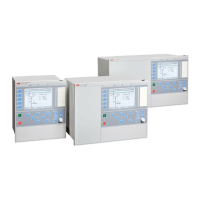about system disturbances and their possible causes, it can also detect problem
conditions throughout the system before they cause customer complaints, equipment
malfunctions and even equipment damage or failure. Power quality problems are not
limited to the utility side of the system. In fact, the majority of power quality problems
are localized within customer facilities. Thus, power quality monitoring is not only an
effective customer service strategy but also a way to protect a utility's reputation for
quality power and service.
CMHAI provides a method for monitoring the power quality by means of the current
waveform distortion. CMHAI provides a short-term 3-second average and a long-
term demand for TDD.
10.1.6 Signals
Table 681: CMHAI Input signals
Name Type Default Description
I_A Signal 0 Phase A current
I_B Signal 0 Phase B current
I_C Signal 0 Phase C current
BLOCK BOOLEAN 0=False Block signal for all binary outputs
Table 682: CMHAI Output signals
Name
Type Description
ALARM BOOLEAN Alarm signal for TDD
10.1.7 Settings
Table 683: CMHAI Non group settings (Basic)
Parameter
Values (Range) Unit Step Default Description
Operation 1=on
5=off
1=on Operation Off / On
Demand interval 0=1 minute
1=5 minutes
2=10 minutes
3=15 minutes
4=30 minutes
5=60 minutes
6=180 minutes
2=10 minutes Time interval for demand calculation
Demand window 1=Sliding
2=Non-sliding
1=Sliding Demand calculation window type
TDD alarm limit 1.0...100.0 % 0.1 50.0 TDD alarm limit
Table 684: CMHAI Non group settings (Advanced)
Parameter
Values (Range) Unit Step Default Description
Initial Dmd current 0.10...1.00 xIn 0.01 1.00 Initial demand current
1MRS758755 A Section 10
Power quality measurement functions
REC615 and RER615 675
Technical Manual

